-
Mrs. Two Shacks Builds a Fowl Go-Kart and a Hen Harem

And its a... go-kart? Okay, so… my chickens are currently in a deluxe San Diego summer unmovable chicken tractor. The tractor is too heavy for me to move, and the wheels (reused) have literally crumbled apart. Now it is November and the nights are becoming chilly, and we’re on the weekend rain schedule, unlike our other dry years. (Normally it rains the weekend after Thanksgiving when all the holiday events are happening, which gives the weeds time to grow so that everyone is mowing just before New Years.) My hens are cold. I know, it isn’t Minnesota; the nights are in the 40’s, but that is nippy to Southern California-bred chickens. I’ve been pondering what to do for some time now, and my Libra self has vacillated so much that now I’m up against it. Yesterday I devoted to trying to build a warm place for the chickens. I ended up with a go-kart.

I have a cage and a crate: I'll put them on wheels! I am not one to cut wood. I go out of my way to find matching pieces of wood in my huge and glorious scrap pile just so that I don’t have to measure and cut wood, because invariably I will cut it the wrong length. Fabric, too, (I have some interesting curtains). Determined to make a warm, cozy hen structure that was safe from predators (a coyote jumped the fence and killed Kakapo and took Linnet on Saturday. I was and am heartbroken and angry. I have three hens left. Oh, and Emerson.) I found a huge wooden crate that was used for a sculpture of a rodeo rider, which belonged to my parents. This thing has been taking up space for maybe twenty years in various locations. It looked the perfect size for three hens. I dragged it down the hill to the newly-straw-covered area in front of my new two sheds.

Hammering together four pieces of wood on wheels takes skill Fifteen years ago, at another house, in another life, I built a movable chicken coop that was gosh-darn good. I didn’t cut any wood for that one, either. Anyway, I still had the casters left. Pulling two long and two short pieces of 2×4 (notice I don’t give a length) out of the wood pile, I hammered them together and attached the casters, although not in that order, which made the hammering together more difficult. I purposefully didn’t use screws: I wanted to bang away with something hard on something yielding. I attached the crate after scraping out the spider webs. Now I wanted a caged area for the hens to be able to graze and get some sun. I still wasn’t completely sure where I was headed with all of this, but I was driving anyway. I dragged down an old large animal cage, which used to support a heat lamp for my African Spur Thigh tortoise until he outgrew it and tore the door off. I could fit it onto the front part of the… thing… and the casters would go through the holes in the bottom with a little help from a PVC hacksaw. (Cutting PVC is NOT the same as cutting wood, by the way, and I have oodles of experience with it. Red Hot Blue Glue nearly runs in my veins.)

The wheels fit through the wire! Wheee! I found some brackety-gizmos that made an L shape, and attached them to the bottom so that the cage hung down closer to the ground so that the hens could get at the grass.

L-shaped thingies, and the hammer head that kept flying off I attached two pieces of wood in a ‘T’ as a handle (trying to hammer it onto the frame through the cage), and then found an old dog choke collar with some lead still attached, and wrapped that around to help pull.

The pull handle, complete with choke chain. So, what if it rained? It needed a roof. There happened to be three of these triangular things left from the shed removal. I’m glad they were put to use. They had been a failed attempt to put up cat fencing (to keep them in the yard) on top of the shed roof by a friend who was a contractor. (He’s also the reason why the 8-foot wooden fence I asked for turned into a 5-foot fence up on bricks with a teal slanted cap running along the top… which makes a nice foothold for the cats.)

I knew there would be a use for these, if I waited long enough! I nailed these suckers on the crate, (ever try to nail something triangular?),

Ever try to hammer something triangular? (The successful nail is on the outside end!) then pulled out a piece of corrugated aluminum that wasn’t too sharp (and was also conveniently on top of the pile). It was too long, and not wide enough, so I grabbed some big scissor things I’ve had in the shed for years and cut the aluminum in half (they were tin snips!). Roughly. On purpose. Of course, the piece I cut didn’t fit, so I had to bend it in half, stepping on it, and drape it over the triangles then nail it on. The larger of the two I used towards the front, to give a little shade. The sun was going down and I had to hurry.
Then stuffing straw in the gap for insulation, adding a milk crate and straw inside for eggs, I stepped back to enjoy my creation.

Ummm, doesn't quite fit. Well, it wasn’t quite a chicken tractor, and it wasn’t quite a warm and cozy house. It was a go-kart.

Hay insulation I had thought to move it and the hens up into the relative safety of the tortoise and cat yard, since the cats were not allowed into the yard right now because two naughty individuals escape (so everyone else has to suffer, just like in school). With much pulling and pushing, I managed to get the kart around to the front of the hen house, and there it stayed overnight. I couldn’t get it any farther. The casters would work fine if the mulch wasn’t so thick, and if I didn’t have to pull it uphill. There was no way I was going to be able to get the kart uphill through the mulch into the tortoise yard.
Today I managed to move the kart over some grass, and one by one brought the hens over and popped them in. I got some very curious looks back from them. The chickens thought it was pretty fun, and enjoyed pulling at the tops of the grass sticking up through the cage, but after awhile they set up a chorus that couldn’t be ignored. And I still hadn’t solved the problem of their being cold at night! It was again about to be dark.

Hens wondering how to make it go Grabbing a rather stinky dog blanket, an old flowery sheet and a pillowcase (they were there, all right?) and the staple gun, I went to work. I stapled the blanket all across the back of their regular hen house loft, across the roof and let it dangle down in front of where they roost at night. Sticking my head in there (and holding my breath…. very doggie-smelling) I noticed a slight breeze still, so I stapled up the sheet and pillowcase. Emerson was quite baffled as to what I was doing next door.

How to make an expensive, well built chicken tractor look like junk in ten minutes. Then I brought the hens back, and figured it would have to do until after the holiday. A day and a half’s work and I have a heavy fowl go-kart and taudry drapings around the hen house, but I think the hens are warmer tonight. And, I must say, I think the kart is pretty cool-looking.

Gipsy hens Happy Thanksgiving!
-
Subversive Gardening

Veggies I’m going to cheat on original material in this link, and urge you to watch Roger Doiron (of Kitchen Gardeners International) talk about the gardening revolution. The important points are about the famine, obesity and monoculture problems and how we can save ourselves with backyard gardening… no different a message than Geoff Lawton’s, who says that all the world’s problems can be solved in a garden. The Doiron video is entertaining as well as informative, so please take a few minutes to watch it. I found it on a link from Treehugger.com, which has today several good articles about the Occupy movement, having a beehive, making a rocket stove and a wedding dress made of rubber gloves! Scroll down this link to watch the Doiron video here: http://us.mg201.mail.yahoo.com/dc/launch?.partner=sbc&.gx=1&.rand=7do57p67k7bh0 .
-
Rain
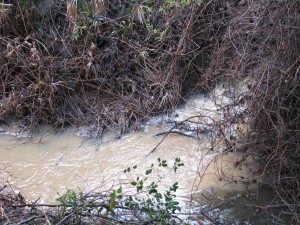
Runoff An interesting fact, especially for those of us in low-rain areas: An inch of pH neutral, nutrient-freeing, perfect rain falling on one acre of land is the equivelent of 27,154 gallons of water. Yep. Where does it go? For most people, it runs off into the storm drains and eventually to the ocean where it becomes salty and unusable without treatment. Then a couple of weeks later, on come the sprinklers delivering not-so-good quality expensive domestic water, further locking up the nutrients and killing the microbes in the soil. How can you capture that wonderful resource of natural rainwater? Water barrels are alittle help, but mostly what you need to do is shape your soil to catch the runoff. Swales, deep loam, and strategic planting can quickly take all that water… even the amount that pours off of your roof, and capture it in the soil. The water slowly sinks and moves the way it was going before, but without taking the topsoil with it. As it moves, the plant roots absorb it over a long period of time, along with all the nutrients that pH-neutral rainwater has freed up in the soil. Your landscape will be stunning, your water bill can eventually be reduced to zero, and if you grow food plants, the nutrition level in them will rise. Here is a video from permaculturalist Geoff Lawton with graphics: http://www.youtube.com/watch?v=UFeylOa_S4c.
This is the essence of permaculture. Simple, logical effort to use what we already have to return the soil to the sponge it was before we compacted it. So how large is your plot of land? Nine acres? A back porch with pots? You can still do the math and see how much water you can capture. Look up rainwater harvesting videos on YouTube and see plots of land in the desert that harvest rainwater and are oasises of food, habitat and beauty, without supplemental water. Here is what Lawton has done with ten acres in Jordan: http://www.youtube.com/watch?v=xvmx4lcqQVw. If they can do it on that scale in that poor an area, any homeowner can do it.
- Chickens, Gardening adventures, Humor, Permaculture and Edible Forest Gardening Adventures, Vegan, Vegetables, Vegetarian
Planting Easter Dinner (in November)
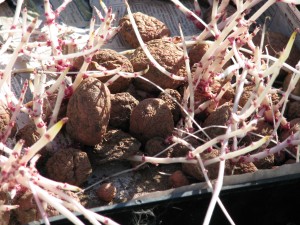
Creepy white fingers I finally was able to work in the vegetable garden today; me and my helpers, that is.
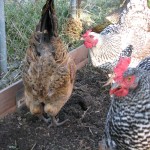
Kakapo, Miss Amelia and Lark, helping I am by no means done, but I did some major cleaning out of old veggies. Out went the tomatoes that aren’t producing, dead squash vines, weeds, a volunteer avocado tree and the two enormous zucchini plants which, although having been cut in half, abused and ignored, have still been putting on a squash a week. I have one more zuke plant left, but these big guys had to go. The compost heap is… well… a big heap.
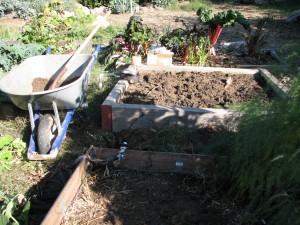
White potatoes in the closest bed, root veggies and brassica seeds in the back one As I study Permaculture, I’m more aware of the millions of microbes in the soil and the fine network of fungus that enriches plant roots. The less I disturb my garden soil, the better. After pulling the weeds, I sprinkled on GardenAlive’s soil enhancer, which are more microbes, as well as their organic Roots Alive fertilizer. I used a trowel to lightly work it all just under the soil surface, then topped it with compost from my compost bin. Having soil that is healthy, rich smelling and alive is any gardener’s dream. All those microbes free up nutrients in the soil so that your plants can suck them up and use them, which makes your veggies not only healthy and more resistant to bugs and diseases, but produce … um…. produce that is loaded with vitamins and minerals. Its like the old gardener’s joke: A gardener asks a man what he puts on his strawberries, and the man answers, “Cream.” The gardener shakes his head in disbelief and says, “I always put manure on mine.”
Potatoes from spring, which I’d stored in a dark cabinet under the house, decided they didn’t want to wait any longer.
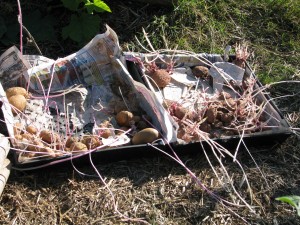
Eager potatoes Fall is a good time to plant potatoes, as long as you keep their greenery protected from frost. Since potatoes can be grown from cuttings (as well as tubers and seeds), and to produce more potatoes you slowly mound up compost or straw around the stem as it grows, I tried something with these long white fingers. I lay each potato on the soil, with the long white stem laying flat, and covered them all up with light mushroom compost.
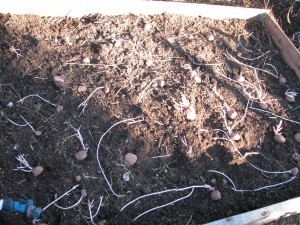
Laying down the potato stems to form new plants I’m betting that the stems will all take root and send up greenery along the nodes, using phototropism. That will multiply the number of potato plants by a lot. Then as the greenery grows, I’ll add more straw and compost around them. If all works out, sometime early next year I should be Potato Queen of Fallbrook! Of course, I had lots of help with the project.
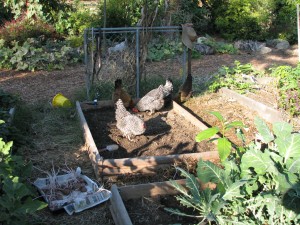
Lots of helpers. I fenced off the beds after I planted A few months ago I planted pieces of yam that had started to grow in the house. The vines flourished outside of the bed. Now that I’ve cleared the massive zucchinis out of the way, I’ve pulled the vines back into the bed, layed them out so that they (mostly) touch the soil, and have dumped mushroom compost on parts of them. The object is to allow them to root along the vines and make more yams. I’ll let you know if this works or not.

Taming the yams I’m also planting carrots and parsnips. The ‘nips won’t be ready until next spring, having improved in flavor for any frost we may receive. I’m hoping there may be some small carrots ready for Christmas dinner, but I really should have put them in last month to be sure. In will go the brassicas: Brussels sprouts (did you ever wonder if it smells cabbagy in Brussels?), broccoli and cauliflower. These guys all like a good chill, as long as they are protected from frost. More cool-weather lettuces will go in, as well as lots of endive for my tortoise. Onion sets and seeds can go in, as well as radishes. The arugula has reseeded itself again and is coming up in all the pathways, with even an elegant specimen right next to the large pond by the rushes!
You remember the pond, which was put in to attract wildlife, right?

Wildlife gathers at the watering hole.... I still have tomatoes and eggplants producing. I tied up the lazy ferny stalks of my first-year asparagus to get them out of the way. The horseradish plant seems to be doing well; I have to consider what to serve it with at Christmas. My dad loved horseradish sauce, as do I, and I grow it as a memory of him and our Polish heritage on his side. I used to make him his favorite soup, borscht, but I would never taste it because I just don’t like beets.
Tomorrow, if I can move my joints after many days of weeding, I’ll clear out the remaining ’empty’ bed and cover the unused ones with compost and straw to sit until spring. I am so glad that I can garden almost year-round!
-
Giving Back

- Assortment of edible pumpkins and squashes on their way to the Food Pantry
If you have extra fresh fruit or vegetables from your yard or garden, or canned goods, please keep the Fallbrook Food Pantry in mind. They need fresh food as well as canned, all the time. The people who pick up weekly supplemental food are screened, given an ID card, and must prove that their income is below the Federal Poverty Level. These people are single parents, people with injuries, the elderly, school children and babies, and they all must have food to live. Instead of sending money and effort to people in other countries, why not help your neighbors? Pick your limes, lemons, oranges, gather your squash and donate to the Pantry. It is quick, easy, and helps people stay healthy and focused on getting through their day. With Thanksgiving feasting upon us, please think of those who just want to eat.
- Bees, Chickens, Gardening adventures, Other Insects, Permaculture and Edible Forest Gardening Adventures, Vegetables
Crazy-Pot Seeds
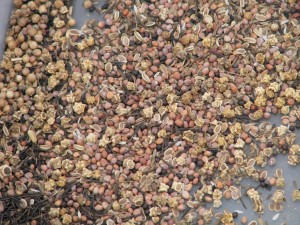
Crazy-pot mixture of veg seeds Today, the palindromic 11/11/11, was also Veteren’s Day and a day between two rainy weekends. A perfect day for spreading lots of seeds. With winter rains on their way in a month, it is important to hold the topsoil with rooted plants, and why not use a cover crop that also fixes nitrogen? My choices were hairy vetch and a tall native lupine.
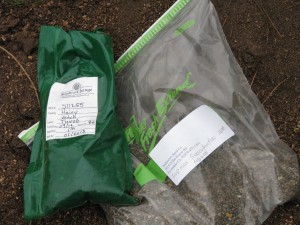
Native lupine and hairy vetch seeds I would also have liked to use white or sweet clover but sources were sold out early this year. Both my choices will have flowers that offer plenty of nectar to bees, be lovely, hold the soil, set nitrogen, and can be, if needed, sacrificed. When you ‘sacrifice’ a nitrogen-fixer, you can either turn it under or cut the tops, leaving them in place on the soil surface to decompose.
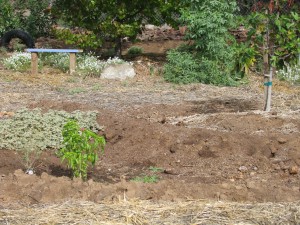
Plant guild waiting for seeds I don’t agree with disturbing my soil microbes any more than necessary, so I won’t be tilling ever again. When you cut a nitrogen-fixer, the roots release the nitrogen they hold into the soil as the tops mulch then decompose bringing lots of nutrition to the soil surface. Vetch should be a winter crop, and lupine a spring crop, if they can tell the difference here in San Diego!
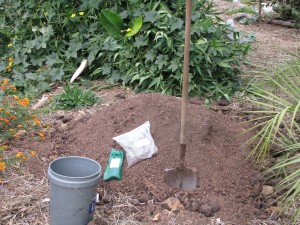
Mixing seeds with mushroom compost My method for spreading these two was to mix handfuls of each with a bucket of mushroom compost, and hand spread it in the most bare and most unfertile areas.

Broadcasting lupine and vetch seeds mixed with compost Adding the compost, I thought, helped the seed distribute more evenly, gave it a little cover since I wasn’t going to rake it in, and disguised it from birds a little.
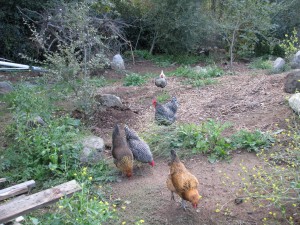
The girls. Once done, I decided it was also a good time to do something I had been looking forward to doing for years: spreading old veggie seeds. I’d done a little of this in a raised veggie bed, with some success. I have so many old packets of veggie seeds that I’m not going to use in the raised beds (I have all organic seed now), and I can’t believe that it isn’t viable. If they sprout seeds found in ancient Egyptian tombs, then I’m sure mine can sprout, too. This seeding is a very important step in the edible forest garden.
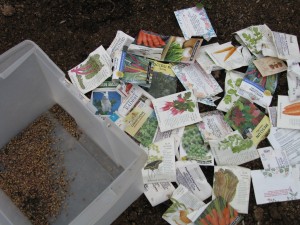
Many old winter crop seeds This year’s abundance of herbs, squash and tomatoes has been fabulous… I still have some ‘feral’ tomatoes putting on enormous fruit which I pick, polish and eat out of hand in the garden while I’m working.
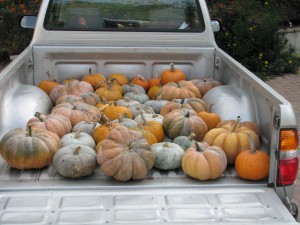
Pumpkins and squash on their way to the Fallbrook Food Pantry I opened all the packages of seed for cool-weather vegetables, such as carrots, radish, dill, broccoli rabe, and lettuces. Some such as garlic chives and onion I separated out and sprinkled near roses, since alliums are a companion plant for roses and help ward away aphids. The rest of it was mixed up in a lovely crazy-pot of seeds. I didn’t mix with compost this time, as there were fewer and smaller seeds involved. I sprinkled them then covered them with soil using my foot… the professional way to plant!
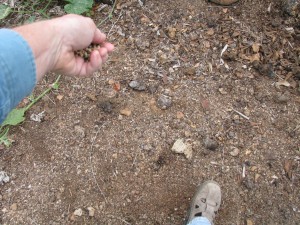
Scattering veggie seeds I am eager to see what comes up after the rain this weekend. It truely will be an edible landscape. Even if I allow the veggies to go to seed, the blooms will all be excellent bee food sources, especially the carrots and dill. None of these were nitrogen-fixers, because I used all the extra peas up in the vegetable beds this spring (see archives) improving the soil. Beans, and other warmer-weather seeds I’m holding back for February or March planting. I do have sweetpea seeds to plant out, but the lupine and vetch will be working their magic anyway.

Embankment with ragweed, now seeded with lupine and vetch 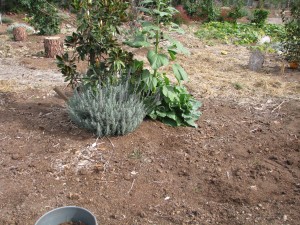
Under the soil is now daffodil bulbs, lupines, vetch and mixed vegetable seeds About ten years ago I had a short story published in the young person’s magazine Cricket called Taking Tea with Aunt Kate. In it a girl lived with her mother who was a wild, messy gardener, spreading seeds all together and having veggies and flowers mingling in riots of color. The girl’s aunt is, by contrast, perfectly coiffed and takes her to a formal ‘high tea’ at a prestigious restaurant. The girl decides that she can be a little of each woman, a little wild and a little formal. I think I’m that child! I clean the dirt out from under my nails so that I can go to the opera.
I’ll be walking the garden in the next few weeks, waiting for tell-tale sprouts (and trying to figure out if they are weeds or not!), and watching the bare areas come to life. How fun!
-
The Little Guys in the Soil
I know, I know, I’ve been very delinquent. However I have been working hard, reading a lot and studying. I’m taking a Permaculture Design Course in San Diego on most weekends, and the information has been dazzling. Even though I know a little or a lot of what is being presented, what amazes me is how related the information is and how it all works together. For instance…
Gardeners know that the best pH for soil is somewhere around 6.5. Higher or lower than that and the soil has too much acid or alkaline. Here in San Diego we have alkaline soil. Rainwater is excellent because it has a neutral pH. What is so important about that neutral pH? Well, I’m going to tell you. There are all kinds of nutrient in the soil in the form of trace minerals, such as iron, magnesium, copper, etc. However these nutrients are bound up in the soil because of the pH… some are bound by a high pH, some by a low pH. For instance, we have adequate iron in our soil, but because of the alkalinity, plants can’t access it and become iron deficient. If you have neutral pH, then plants are able to feed themselves nutritiously. To free up the iron, you should add mature compost and water as much as you can with collected rainwater.
Okay, so you knew all that. So did I. Here comes what I think is the interesting thing.
We know that the soil is teeming with little beings such as bacteria, fungi and nematodes. Some are good, some are bad. Such is life. Picture if you will the soil in a forest, which has a lot of large materials such as logs and sticks being broken down by various fungus. The soil in a vegetable garden, however, is loamy with small particulate matter. Well, in a forest situation, with an acid soil, there is high fungus activity and lower bacteria count in the soil. The soil isn’t usually turned over or bothered in any way. In a vegetable garden, a slightly more alkaline soil is perfect because it has less fungus and more bacteria. The soil is turned over frequently. Weeds such as grasses prefer a pH range that is slightly more alkaline. By changing the pH with the addition of different kinds of mulch, you can moderate the microbes in the soil, tipping the balance between fungi and bacteria, and edging out the grasses. Cool, huh?
Fungus is extremely important where longer-lived trees are planted, because fungus travels underground, linking with the spreading roots of the trees and actually causing communication between them! Fungus, it has been said, is nature’s Internet. Mushrooms are called nature’s teeth, too, but that is an image that perhaps you just don’t want in your head. Bacteria help soil that is often disturbed by helping leguminous plants fix nitrogen (yes, yes, I know, back to the darn legumes again), and help free up nutrients for the roots, usually by dying. That’s not a happy thought but, again, that’s the way it goes. If you till the soil, you kill off the bacteria and nematodes and fungus and all the other little critters. There is a rise in fertility, but only briefly because that rise is the nutrition released by the decomposing bodies of all your soil critters! Then there is just dead soil. Then farmers pour on the salt-based fertilizers (NPK), which is just salting the land and making sure nothing can live in it. The crops grow, but since there aren’t any friendly critters freeing up nutrients, the resulting nutritional value of the produce is poor. Only by mulching, composting, and cover-cropping can the soil come alive again, which nourishes the plants, which nourish us.
There is so much life in just a pinch of soil; so much going on that we still can only guess at. To build up your soil with mulch, compost and organic practices is to give life to gajillions of life forms (yes, that many!) which all work to make your plants healthy, your food more nutritious, and gain back some of the topsoil that has disappeared through man’s blundering.
I hope this was as interesting for you as it is for me!
- Bees, Gardening adventures, Other Insects, Permaculture and Edible Forest Gardening Adventures, Vegetables
Nitrogen-Fixing Plants

Sweet pea If you’ve read my posts from this spring, you’ll have endured me going on and on about peas and beans and how they fix nitrogen in the soil. For those who nodded off during those episodes or who have just tuned in, I’ll go over it briefly.
Some plants have the ability to fix nitrogen in the soil. Actually, a type of bacteria called a rhizobia invades the roots of plants in the Fabacea family and a few others, and fixes atmospheric nitrogen in nodules on the plant’s roots. This is beneficial to both the plant and the bacteria, a process called mutulism. It also benefits whatever grows around the plants because, when the plant dies, the nodules release their nitrogen into the surrounding soil. In the case of long-lived shrubs and trees that fix nitrogen, as roots die off or are replaced, they release their nitrogen.
An edible forest garden is one where man mimicks the dynamics of an old-growth forest. Why? Because forests succeed without the aid of fertilizer, tilling, mulching, irrigation or any interference or ‘help’, as it were, from man. How does it do this? The plants that grow complement each other, providing what each other needs. These relationships are called plant guilds. You can create plant guilds, substituting plants that provide food for humans. In a guild there is a taller tree which provides shade and leaf droppings (mulch), shrubs which provide more shade, mulch and habitat for animals and insects, plants that fix nitrogen in the soil, plants that have long tap roots called ‘miner’ plants, because they take up nutrients from deep in the soil and deposit them on the soil surface when their leaves die off, plants that attract pollinators, and plants that are ground covers to regulate heat and moisture. Using permaculture practices for water harvesting and organic gardening, when the guild matures it should be almost completely self-sustaining.
Say you want to plant an apple tree. That would be your tall canopy tree for the guild, which drops leaves as mulch. Beneath it, you could plant a shrubby herb such as rosemary (another edible), daikon radishes (miners, leaving the cut leaves on the surface after harvesting the edible root), bush beans (legumes) and herbs such as dill, parsley and basil, some of which you allow to flower for pollinators. As the tree grows, the plant guild can widen and others planted.
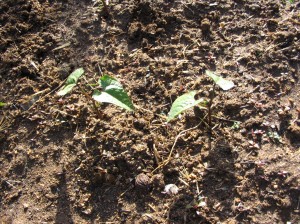
Beans There are many plants, trees and shrubs that fix nitrogen in the soil. All beans and peas including soybeans and fava beans do; when the plants are finished cut them above the soil so the roots stay put and decay where they are to release the nitrogen. Cover crops such as clover and hairy vetch are grown and turned under to improve the nitrogen in the soil. If you are from the Southern California area, perhaps you’d be interested in knowing what native plants are nitrogen fixers.

Ceanothus (California Lilac) at Elfin Forest The native Southern California nitrogen fixers include: ceanothus, lupine, deerweed, California peashrub (endangered) (lotus), and redbud. Non-natives that are commonly used are alders, acacias, calliandra, sweet peas, guaja, and many more, as the Fabacea family is very large. Use any of the natives in ornamental gardens and not only will you be improving the soil and the vigor of the surrounding plants, but providing much needed habitat for our native birds and insects.
Try building plant guilds; it is challenging and fun. Many combinations of plants are suggested on permaculture
-
Jook
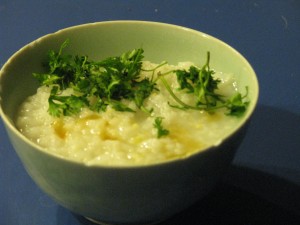
Jook with sesame oil and chopped cilantro Jook, Juk, Chinese rice soup, rice porridge, congee… these are many names for basically the same food, rice cooked with a lot of water. There are equally as many ways to fix this wonderful comfort food. Jook can be made with plain water and white or brown rice, then served with toppings such as cilantro, sesame oil, chopped peanuts, bits of cooked tofu, soy sauce, chopped hardboiled egg, preserved or cooked vegetables, chives… as little or as much as you’d like. Jook can be prepared with or without salt; I prepare mine without, then grind a little on the top when serving for that little burst of flavor. Jook can be served with cinnamon and sugar for dessert; this is especially nice for those who love rice pudding but don’t want to eat or can’t eat dairy. Commonly eaten as a savory breakfast dish, Jook is also a perfect food for when you are ill. Not only is it comforting and filling, but it is easy to eat for a sore throat, easy on a troubled stomach, nutritious, and if you are a victim of Montezuma’s Revenge (if you know what I mean), rice is very good for helping you to stop going. Ah-hem. Jook is a very good baby food for those little mouths that are just getting into semi-solids.
You can find hundreds of different versions of Jook on the Internet. Many make it with part broth, part water. Some throw in fresh ginger, some cook bones in it for added calcium. Cooking it plain allows you to top each bowl up the way you want, which is what I do. Leftover Jook can be mixed with water to loosen it up, or eaten in its more solid form. You can’t get a much easier comfort food to make that is so versatile. It is particularly good for celiacs (those who cannot eat gluten). With cooler weather upon us, make one dinner a Jook day!
JookAuthor: Diane C. KennedyRecipe type: MainPrep time:Cook time:Total time:Serves: 6-8Jook, rice porridge, rice soup or congee, is a wonderful versitile comfort food.Ingredients- 1 cup washed white rice (short or long grained depending on your taste)
- 8 cups water (if you like it thick)
- or
- 10 cups water (if you like it medium)
- or
- 12 cups water (if you like it very thin and soupy)
- optional: 1-2 tsp. salt)
- optional: substitute broth for equal parts of the water)
- optional: add a thumb-sized knob of fresh ginger)
- Topping suggestions:
- sesame oil, peanuts, fresh cilantro, chopped hardboiled egg, cooked tofu, seaweed, soy sauce, freshly ground salt and pepper, butter, cooked vegetables, pickled vegetables... leftovers. Also make it sweet with sugar, honey, cinnamon, nutmeg, dried fruit, chocolate chips!
Instructions- Put washed rice and the desired amount of water in a dutch oven
- Heat until boiling
- Turn down heat to a simmer and cook uncovered 2½ - 3 hours, depending on how thick or thin you want it.
- Serve hot in small soup bowls with choices of toppings.
- Gardening adventures, Permaculture and Edible Forest Gardening Adventures, Photos, Ponds, Rain Catching
The October Garden
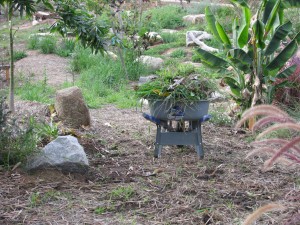
Weeding The weeds took advantage of the warm weather and my absence last week to really get some growing in. I’m pulling each weed by hand, shaking off the dirt (trying not to get showered with it in my eye), and composting them. The greens when layered with brown material (dead clippings, etc.) will cook nicely for use next year. I have a tall wire cage set up in one of the raised beds I haven’t filled yet, so the compost will be made right where it will be used.
Meanwhile the garden grows. Melon vines are dying, but the squash continues on!

Luffa vines grew up the palm trunks, then down again to the ground! With permaculture the idea is to mimic a forest dynamic, with lots of plants helping each other grow by providing elements other plants lack, such as nitrogen, mulch, shade, flowers to attract pollinators, etc. You can fit a lot of plants into a small area.
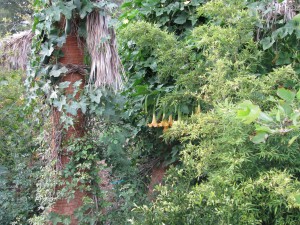
You can fit a lot of plants in a small space with adequate nutrients and water 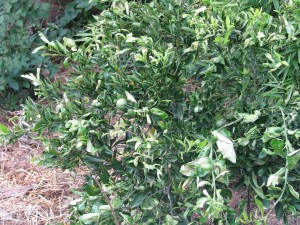
Trouble with citrus The orange tree above is receiving too much irrigation water due to its placement on sloping land and the nearness of water-loving plants. Planning beds with compatible plants providing adequate initial nutrition and water can result in happy masses of plants.

The palm walkway has become a jungle tunnel 
Bamboo and sugarcane 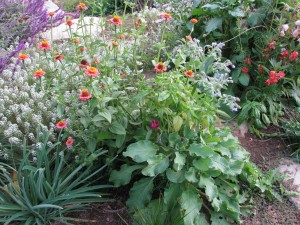
Bee and butterfly seed mix The pond, now six months old, looks as if it has been on the property for years.

The pond looking natural The melon vines and pumpkins have not only protected the land from the scorching summer sun, but will provide good compost and certainly are decorative as well as sources of food. I always wanted to wait for the Great Pumpkin!
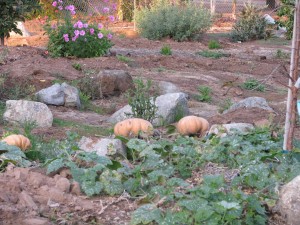
Cinderella pumpkins, with purple cosmos across the dry streambed Sages, mints and butterfly bushes continue to flower, providing much needed pollen sources for bees in this season of dearth.
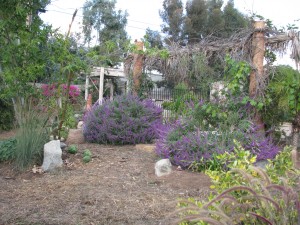
The entranceway 
Bananas and sage Meanwhile in the vegetable garden many crops have had their day and I’m composting them as I get to them. Some such as the eggplant are still going strong. (See my steamed eggplant recipe! Yum!) .

Another giant eggplant hiding in the strawberries A garden as large as this can be overwhelming, especially in its first year. I’m trying to think in sections. I enjoy working the garden, making it mine and seeing the surprises that show up. My back and hands aren’t as happy, especially the morning after, but… too bad! “Get over it, guys!” I say, then realize I’m talking to my body parts. Alone in my garden, only the plants really care, and they aren’t looking. Or are they?
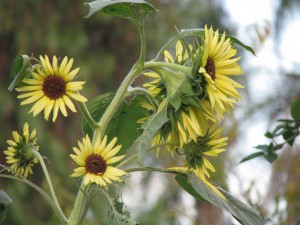
Sunflower keeping an eye out in all directions
